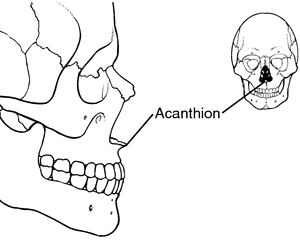maxilla

Maxilla, Credit: Gray's Anatomy.
A maxilla is one of a pair of bones that forms the upper jaw of the skull. At their base the maxillae carry the upper teeth and form the roof of the mouth. At the top, the maxillae form the floor of the orbits (sockets) of the eyes. Each maxilla contains a large air-filled cavity, called the maxillary sinus, which is connected to the nasal cavity. The two bones meet at the intermaxillary suture and form the lower margin of the nasal aperture. Below the orbit the maxilla is perforated by the infraorbital foramen. The alveolar process projects downward and, together with its fellow on the opposite side forms the alveolar arch, which carries the upper teeth.
Incomplete fusion of the maxillae leads to cleft palate and hairlip.
Acanthion

The acanthion is the tip of the anterior nasal spine formed where projecting processes of the maxillae meet at the front of the face.
The acanthiomeatal line is an imaginary line drawn through the acanthion and the auditory meatus (ear canal).


